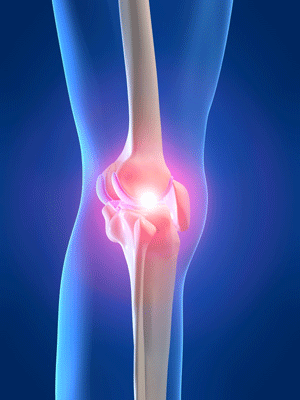
Cartilage is a tissue into a flexible nature and there throughout the body. However, problems often spoken of cartilage in the knee because of degradation not only affects the individual movements, and even everyday life.

For serious cases, the knee must be replaced. In general there are two types of cartilage in the knee; meniscus cartilage – shock absorber between the upper thigh bone (femur) and the large bone in the leg (tibia). While white articular cartilage that covers the ends of most of the shine bone.
It ensures that the bones rub against each other without any pain. Only a few millimeters thick. Articular cartilage serves to minimize the pressure when the individual moves. At the same time, it also serves as a shock absorber.
Unlike other parts of the body, cartilage has no blood supply instead (avascular). Thus if there is a breakdown of cartilage, it can not be recovered quickly as skin or muscle damage. Besides the nature of the avaskular, articular cartilage has no nerve supply also (aneural).
Thus, at the beginning of cartilage injury, you will not feel pain. However, when the injury was more severe or the cartilage began to hollow, it will affect the movement of joints. However, the joint may also have problems of inflammation and pain.
INFO
Symptoms of cartilage damage
1) Pain in joints
2) Joint swelling
3) Knee-lock (lock knee) – knee joint can not be straightened
4) Knee may also be read as it moves, especially if the cartilage behind the knee that is damaged.
Cause of cartilage damage
Among the key is osteoarthritis and usually involving the elderly. while young people often prone to injury because of the involvement in sports.
Cartilage injuries can also occur in children due to infections such as septic arthritis in the joints. In addition to children, septic arthritis also can be experienced among TB patients, HIV and diabetes. In addition, it occurs also in patients with cancer, patients with gout and rheumatoid arthritis (RA).
Treatment of cartilage damage
Non-surgical treatment is generally to help relieve the symptoms of cartilage damage. It’s like:
1) physiotherapy – exercises which strengthen the muscles related to or support the joint can help reduce stress on joints and reduce pain.
2) Medications – such as anti-inflammatory steroid medications such as aspirin or ibuprofen can help reduce swelling and pain.
3) Use support tools – such as a leg brace
4) Changes in lifestyle – reducing activity involving the affected joint.
Treatment of cartilage damage with surgery.
There are several surgical procedures that you can choose to tackle the problem depends on the severity of injury to the cartilage of your problem. Among the most popular is the microfracture – techniques that encourage the growth of new cartilage. It is the most common techniques used arthroskopik procedures. Areas affected cartilage pierced enable bleeding. Although this technique is able to produce new cartilage, but it will not last long and do not have the resilience and strength as the original cartilage.
Another technique is the use of hot stem cells to generate new cartilage growth that matches the original cartilage. However, studies and research about it is new and therefore the use of stem cells in restoring cartilage is still too much to say.


Leave a Reply